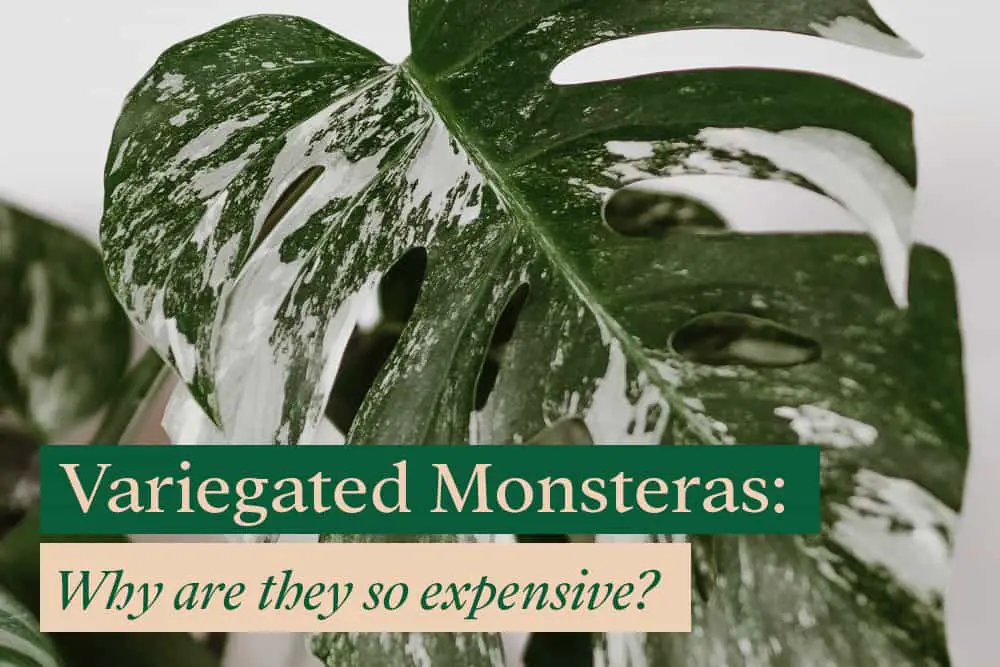
Monsteras are beautiful plants already, and variegated specimens even more so. Unfortunately, they tend to be rare and expensive.
Variegated Monstera plants are expensive due to its rarity. The marbled or a half-moon appearance is caused by a mutation in the plant’s chlorophyll formation. Depending on the size and variegation pattern of a Monstera, their price can range from $100 to a few thousand dollars USD.
Keep reading to learn more:
- What is variegation?
- Why are variegated Monstera so expensive?
- Monstera Albo Borsigiana vs. Thai Constellation
- How to maintain variegation
- How to find a variegated Monstera
Also Read: Monstera Care 101 – Don’t Adopt a Monstera Before You Read This Comprehensive Guide
What is Variegation?
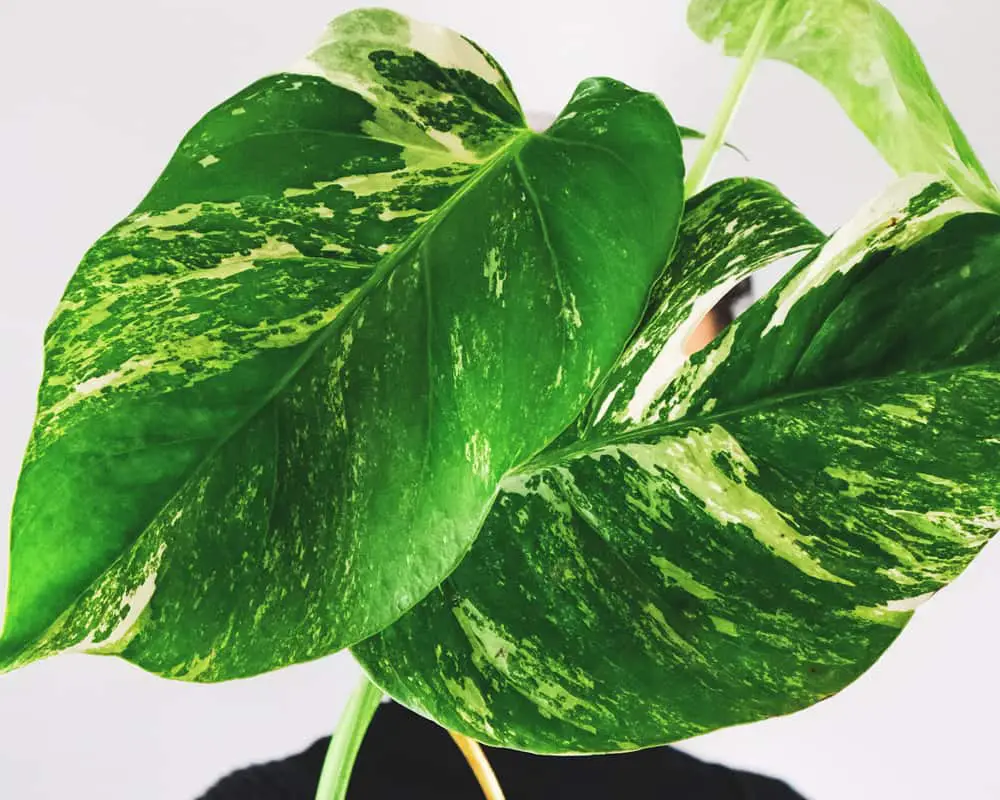
Variegation refers to the naturally-formed lighter patches on a plant’s leaves. These light patches may be light green, yellowish, or even white, depending on the plant species.
The leaves’ lack of chlorophyll is actually stressful for the Swiss Cheese plant because the leaves don’t have as much surface area to photosynthesize. For this reason, variegated Monsteras tend to grow much slower than their non-variegated counterparts.
There are two main kinds of variegation found in Monsteras: marbling and sectoral.
Marbled leaves have patches of light and dark distributed fairly evenly across the surface. Sectoral variegation is when there are large patches of white on the leaf. A leaf can have both marbling and sectoral variegation at the same time.
Why are Variegated Monstera so Expensive?
Variegated Monsteras are so expensive because of their rarity and popularity. The lack of chlorophyll in the leaves means it needs more light and grows slower. Slower growth means slower propagation and fewer new plants.
Online marketplaces that sell variegated Monsteras sell out quickly, putting new potential customers on a waiting list for when the parent Monstera grows enough to produce more cuttings.
Prices also increase due to demand. Growers have discovered that people will pay a lot of money for a variegated Monstera. Even a baby cutting with two leaves can be sold for $100 USD, and people will pay! As variegated Monsteras become more popular and demand continues to rise, the prices will continue to increase as well.
Monstera Albo Borsigiana vs Thai Constellation
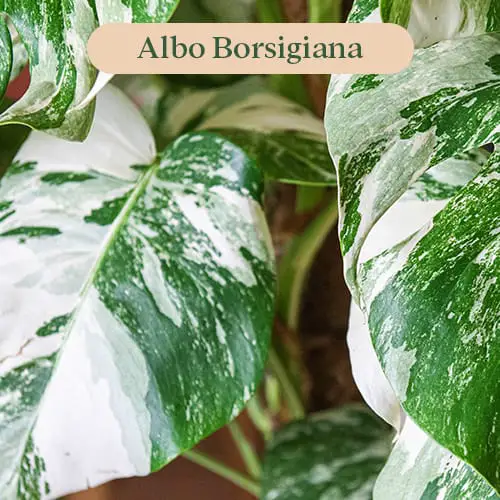
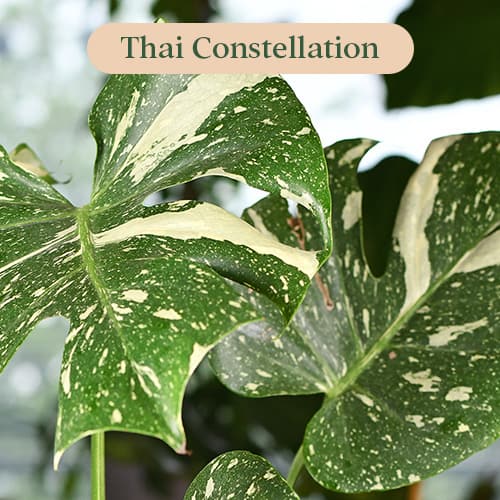
There are two main types of variegated Monstera: Albo Borsigiana and Thai Constellation. While at first glance, they may look similar. They have some apparent differences that will affect their care, growth, accessibility, and price.
Knowing the difference between Albo and Thai will help you decide which one you would prefer to keep in your home.
Mutation – natural vs. tissue culture
The original mutation that causes variegation for Monstera Albo Borsigiana is naturally occurring. At one point, there was a regular, green M. Borsigiana, whose cells started to spontaneously mutate in such a way that those cells did not produce chlorophyll. These mutated cells reproduce in the Monstera’s stem and get passed on to the next leaf.
This natural mutation exists in only the white cells. Seeds from a Monstera Albo will not produce variegated offspring. A new variegated Monstera Albo can only be reproduced from a cutting from a mother plant.
Monstera Thai Constellation has a different origin. It was created in a lab in Thailand from tissue culture. In this subspecies, the mutation that causes the variegation is present throughout the plant, in every cell.
The forms sold – cuttings vs. plant.
Monstera Albo Borsigiana is almost always sold as a cutting from a mother plant. It is rare to find a mature Albo for sale because they take so long to mature; it is more cost-effective for nurseries to sell cuttings. If you do find a mature Albo for sale, it will likely be very expensive.
Monstera Thai Constellation is usually sold as a young plant. It can be grown and sold this way because of its creation in the lab. Tissue cultures develop directly into small plants, which are then potted up in the soil and sold. These baby plants will have smaller leaves to start with and may not have any fenestrations due to their young age.
The variegation pattern & stability
Monstera Albo Borsigiana has a stunning variegation pattern. Its leaves have patches of green, marbling, and white. Each leaf will be different from the next.
Due to its natural mutation, this variegation pattern is unstable. Albo Monsteras may revert to growing fully green leaves, and they may grow leaves that are entirely white with no chlorophyll. These all-white leaves are beautiful but put an immense strain on the plant and will be the first to die.
The variegation on the leaves of an Albo depends on the mutated cells present in the stem and leaf node. This can vary dramatically even within one plant. Each leaf’s coloration will depend on that of the prior leaf. Paying attention to your Albo’s growth and variegation, you will be able to predict how much white and green will be on the next leaf.
Too much white or too much green in new growth on your Monstera Albo will need to be pruned back to maintain a sustainable balance between beauty and photosynthesis.
Monstera Thai Constellation has a distinctly different variegation pattern than the Albo. Thai leaves all have small creamy splotches scattered across the surface like a constellation. The light patches are less of a brilliant white and more of a creamy color. Thai Monsteras have fewer and smaller sectoral variegations than the Albo (those big, white patches).
Thai Monsteras also have much more stable variegation. Due to their creation in a lab, all of the cells in the plant contain the mutation. You do not have to worry about your Thai Monstera reverting to all-green leaves.
While the variegation is stable, it is also unpredictable. From one leaf to the next, there is no progression or regression of white or green leaves.
Inter-nodal spacing
Inter-nodal spacing refers to the length of the stem in between leaves. Monstera Albo and Thai are very different in this regard.
Monstera Albo Borsigiana has a longer leaf node, up to 3–4 inches (10 cm). This means the leaves are spaced further apart.
For this reason, Monstera Albo may not look as lush and leafy, as it will look and grow more like a vine. This variety will definitely need something like a moss pole to climb on.
This more extended leaf node also makes it very easy to take cuttings. There is lots of room to reach in with pruning shears.
Monstera Thai Constellation has a very short internodal spacing, as short as an inch (2–3 cm). This gives the Thai Monstera a very compact, bushy, and lush appearance. However, this makes it harder to take cuttings as there is not much room for the scissors.
Leaf size
Monstera Borsigiana is a sub-species of M. Deliciosa that has slightly smaller leaves. Its leaves are no bigger than a foot wide (30 cm).
On the other hand, Thai Constellation leaves much bigger, more like regular Monstera.
Rarity
Monstera Albo Borsigiana is much rarer than Thai Constellation. It is only reproduced through cuttings, whereas Thai is grown for commercial production in a lab. Albo also grows slower than Thai; slow growth means more time in between cuttings!
Thai Monsteras are still hard to get ahold of. There is only one lab that produces them, and they can only make so many at once.
Pricing
Due to their rarity and demand, Monstera Albo Borsigiana tends to be more expensive than Thai Constellation.
A cutting of Monstera Albo can be sold for $100 USD in some places; some vendors charge more depending on the size of the cutting. A small plant will sell for about $800 USD, and a mature plant will sell for over $1,000 USD.
At the time of this posting, a young Monstera Thai Constellation will cost between $150 and $700 USD, which is less than the cost of a Monstera Albo of the same size. Mature Thai Constellations will also sell for over $1,000 USD. Cuttings of this variety are less common but not unheard of.
That’s a lot of information to remember! Here’s a chart for a quick and easy comparison:
| Differences | Monstera Variegata Albo Borsigiana | Monstera Thai Constellation |
|---|---|---|
| Most common forms sold | Cuttings | Young plant |
| Source of Mutation | Natural mutation | Tissue culture in a lab |
| Inter-nodal spacing | Long, up to 10 cm | Very short, 1–2 cm |
| Leaf size | Smaller leaves, up to 30 cm | Large leaves, 2x–3x as big |
| Variegation pattern | Marbling and large, white patches on green leaves. Some leaves may even be mostly white. | Smaller cream-colored spots on every leaf, like a constellation. Some creamy white or yellow patches. |
| Variegation stability | Not stable. New leaves may revert to green or go fully white. Each leaf’s coloring depends on the leaf before it. | Stable. Will not revert to green. |
| Rarity | Very rare. | Less rare. |
| Price | $100 to $1,000+ USD | $150 to $1,000+ USD |
How to Maintain Variegation?
As mentioned above, Monstera Albo will have unstable variegation, whereas Thai Constellation variegation will not need to be maintained.
Can variegated Monstera revert?
Monstera Albo Borsigiana can start to grow leaves that are all green with no mutation. However, Monstera Thai Constellation will always have variegation on its new leaves.
How do I get my variegation back?
To prevent your Monstera from turning completely green, you need to cut off the leaves with no mutation in them. The mutated cells in the stem and nodes will produce leaves that contain the mutation, but if a node doesn’t have any mutated cells, the next leaf will be green.
You will also want to cut back leaves that are all white. As beautiful as they are, they do not perform photosynthesis and will cause the Monstera to become stressed.
How to Find a Variegated Monstera?
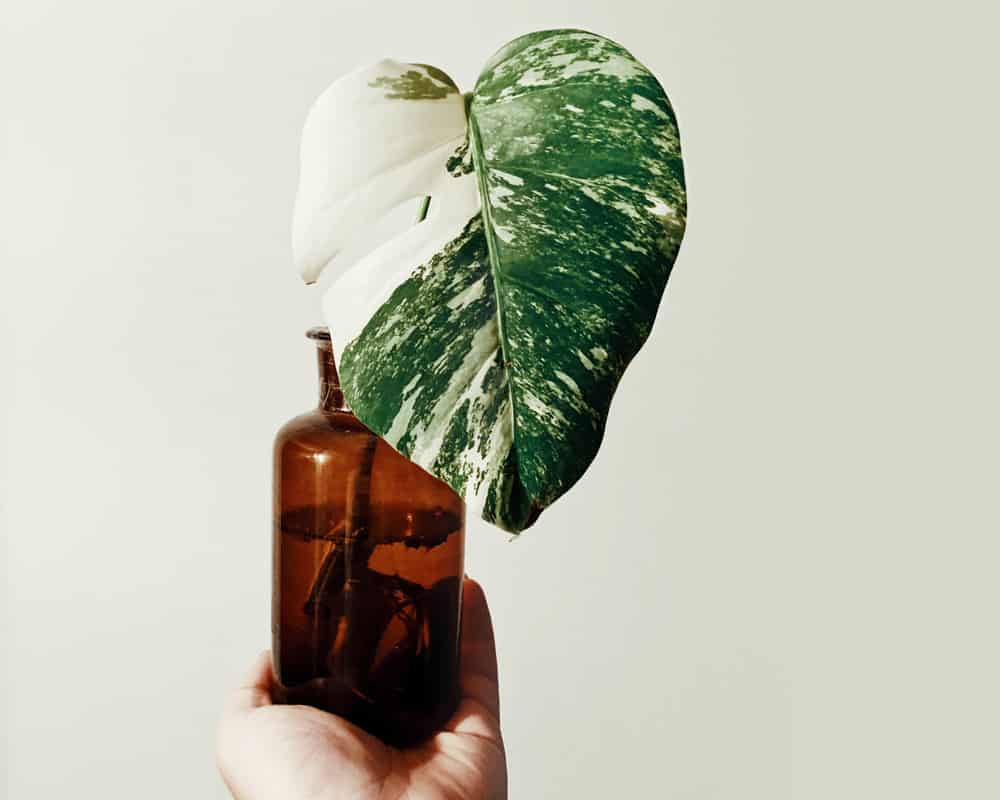
The best place to find a variegated Monstera of either variety is online. Unless you live near a nursery specializing in rare and exotic plants, it is unlikely that you would find one of these beauties at your local grocery or hardware store!
As with purchasing anything online, always buy from a trustworthy place. Due to variegated Monstera’s recent explosion in popularity and price, there are many scams and low-quality products out there. Read the customer reviews always!
Related questions:
Can a Monstera become variegated?
Technically, yes, a Monstera can become variegated, but it is very, very, very rare. The Albo Borsigiana variety originated as a spontaneous mutation. It is far more cost-effective to propagate it through cuttings than to germinate a hundred thousand seeds to see if any have mutated.
Why do variegated leaves grow slower?
Variegated Monstera varieties grow slower because the white patches on their leaves don’t contain any energy-producing chlorophyll. Less energy means slower growth. This means your variegated Monstera will benefit from some extra indirect, bright light.
Also read: Complete Lighting Guide for Monstera: How Much Light Does it Need?
Can variegated Monstera node without leaves be propagated?
Monstera node without leaves also known as wet stick can be propagated into a full-size plant by providing the node with proper care and humid condition.
You can use a ziplock bag to make a mini greenhouse for the cutting. Place an inch-thick layer of sphagnum moss in the ziplock, and half-bury your wet stick on it.
Also read:

